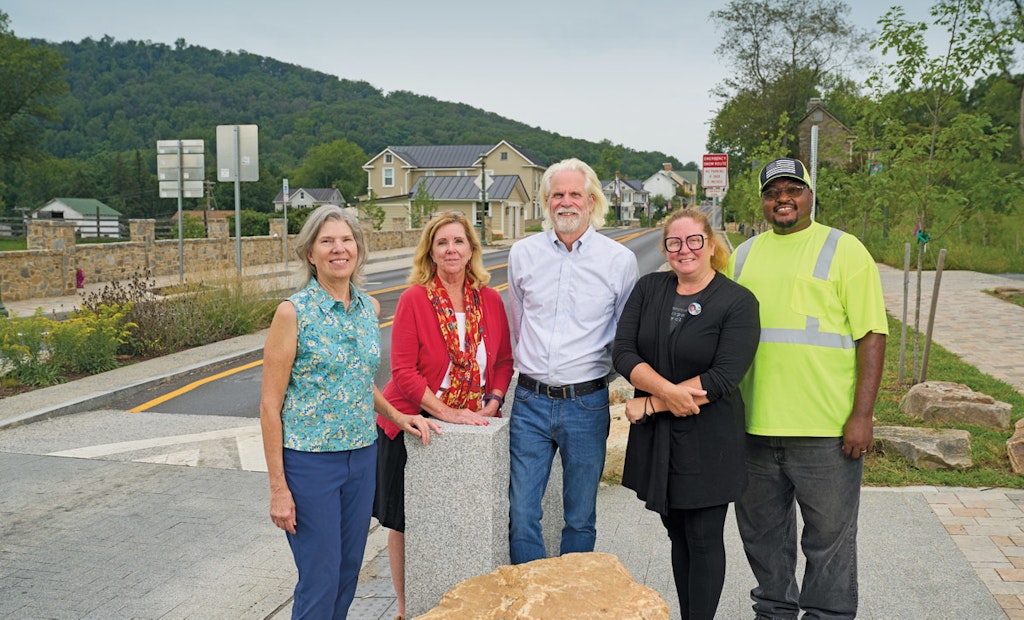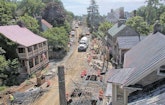
Hillsboro (Virginia) Water Commissioner Claudia Forbes, Vice Mayor Amy Marasco, Mayor Roger Vance, Project Coordinator Alison Badger and Volkert Chief Inspector Jeffrey Shanks (from left) stand along the reconstructed Route 9 corridor in Hillsboro. (Photography by Noah Willman)
Interested in Infrastructure?
Get Infrastructure articles, news and videos right in your inbox! Sign up now.
Infrastructure + Get AlertsEstablished in 1752 in a gap in the Blue Ridge Mountains of northern Virginia, Hillsboro is a small and historic town known for its charming fieldstone buildings that tightly hug State Route 9.
But these days, the community — population approximately 120 and one of the state’s smallest incorporated towns — is making some modern-day history. Led by Mayor Roger Vance and Vice Mayor Amy Marasco, the town recently culminated a 20-year journey by completing a complex $34 million infrastructure project called ReThink9 (as in Route 9).
The project brings the town’s utilities into the 21st century and positions it for growth in the decades ahead. Just as important, it also resolved a host of serious public safety and health issues.
The core of the project centered primarily on just a short, 0.7-mile stretch of Route 9, the community’s main street. But it was mammoth in scope.
Components included:
• A new water system, which relieved residents of a burdensome 20-some-year boil-water order.
• A stormwater management system, a first for the burg, which suffered flooding during heavy rainfalls.
• A complete rebuild of Route 9, a major, well-traveled artery that thousands of commuters use on their daily commute into Washington, D.C., some 45 miles to the southeast.
• A new sanitary sewer system, which eventually will replace failing septic systems and leaking cesspools that degrade groundwater and diminish property values.
• Burial of all aerial utility lines to restore the town’s bucolic ambience.
• Conduit for fiber optic lines, including high-speed internet service.
Surprisingly enough, the project was completed in roughly 14 months. And perhaps even more astonishing, the project was quarterbacked largely by Vance, a volunteer mayor and a former magazine editorial director who’s anything but a professional civil engineer.
Vance and Marasco also cobbled together the $34 million in funding from a variety of federal, state, regional and local agencies. Big-ticket contributions included roughly $12 million from the Northern Virginia Transportation Authority, $14 million from Loudoun County, a $1.5 million federal highway grant and $750,000 from the Virginia Department of Health. The town also floated an $800,000 municipal bond and obtained “a slew” of smaller grants from various entities, says Vance, who served as the town’s project manager with Marasco as deputy project manager.
Determined effort
Oliver Boehm, the head of the landscape architecture and urban design studio at Volkert, a national infrastructure consultant, says he’s never seen anything like what Hillsboro pulled off.
“It was like a college quarterback stepping in and winning a Super Bowl,” he says. “It’s an amazing story. When we’d speak with people at the Virginia Department of Transportation or Loudoun County, they’d refer to Hillsboro as ‘the little town that could.’ They just never gave up.”
Vance believes no other community in Virginia has done what Hillsboro did.
“We essentially took over administration and management of the project while working with Volkert,” he explains. “I think it’s unprecedented at our level … we have no paid staff. We’re just fortunate that Amy and I could devote so much time and energy to this project.”
Claudia Forbes, Hillsboro’s water commissioner, says, “It all boiled down to these two individuals and the incredible time sacrifices they’ve made over the years — and their combined skill sets. Roger really cares deeply about Hillsboro — it’s like his child. And he and Amy have left no stone unturned, from finding funding to creating special events to bring tourists here.
“Every day, I look down the street and think, ‘How did we accomplish this?’”
Traffic safety concerns
The project’s origins stemmed from town officials’ desire to better manage the commuter traffic that coursed through town during morning and late-afternoon rush hours — an average of 17,000 vehicles a day. And during off-rush-hour periods, drivers often ignored the 25 mph speed limit because the road’s two lanes were fairly wide.
In addition, there were no sidewalks along the highway and most of the town’s buildings are set very close to the road, which began as a trade route through the mountains.
“It’s not the safest highway around,” Vance says. “It wasn’t built to handle this much traffic. And it wasn’t safe for pedestrians to walk through town or cross the street. You could barely get out of a vehicle safely.”
So Vance, who’s been the mayor since 2004, decided the town needed to “rethink Route 9 and essentially reclaim our main street.”
In 2007, Ian Lockwood — a well-known traffic-calming expert — helped create a road design that Volkert later refined. The final plan featured a roundabout at each end of town to enhance traffic flow and ease congestion, narrower lanes to “calm” traffic, three raised crosswalks and additional at-grade crosswalks and rustic-looking, concrete slate-finished sidewalks.
But the plans languished for more than a decade for lack of funding.
Persistence pays off
Vance and Marasco slowly amassed funding sources, which helped the project gain traction. Along the way, the duo also realized that rebuilding Route 9 offered a golden opportunity to upgrade the community’s water utility, as well as install a stormwater management system and replace the community’s septic systems — many of which were failing and polluting a nearby creek — with a sanitary sewer system.
Vance says it made no sense to upgrade the water system and install the other improvements piecemeal over a long period of time. So he adopted a mantra: Build it once, build it now.
“It would save a tremendous amount of money and time if we could roll multiple projects into one large infrastructure project,” Vance says. “It made no sense to me to keep digging the street up time after time by doing separate projects.”
Forbes agrees. “We needed all of those things, so why not do everything at the same time? Everyone told us we were crazy, that it couldn’t be done that way.” But it was finished in less time than originally expected, which was 2 1/2 years. Furthermore, doing everything at once saved roughly $11 million, according to Hillsboro figures.
The town received an unexpected assist from the COVID-19 pandemic, which slowed commuter traffic to a trickle, allowing officials to close off Route 9 for a long period of time. That dramatically increased construction productivity, Vance says.
No more boiling
The city’s aging water system was of particular concern. For 200 or so years, the nearby Hill Tom Spring atop Short Hill Mountain supplied residents with freshwater via one of the state’s first gravity-fed water systems. But that ended in the 1990s when groundwater contamination fouled the spring water, which spurred the Virginia Department of Health to issue a boil-water edict and order the community to build a filtration system.
The town couldn’t afford a filtration system and three subsequent attempts to drill new wells failed to find an adequate water supply. But a formal hydrological study led to a viable well on the south side of the community and in July 2020, the boil order was lifted.
The new system consists of about 3,800 feet of 4-inch-diameter ductile iron pipe for raw well-water transport and 5,420 feet of 6-inch-diameter ductile iron distribution pipe, says Alex Hopkins, a hydraulics engineer at Volkert.
The new well is at a low point in town, so the water is pumped into the system, not gravity fed. There are 35 water connections in all and five more are planned.
As for operating the system, the town has contracted with a licensed water operator that stops in once a week to keep an eye on things, Forbes says.
“We needed someone who knows how to operate it. It’s a much more sophisticated system with a computerized control board.”
Controlling stormwater
Rainwater surging down the slopes of nearby Short Hill Mountain often caused dangerous ponding on Route 9 and in some cases, flooded residents’ homes. So the project included 100 catch basins and roughly 6,000 feet of 12- to 36-inch-diameter, reinforced concrete storm-water lines.
From there, stormwater drains through six intermediate outfall channels, then flows into North Fork Catoctin Creek, which eventually drains into the Potomac River.
“That’s a lot of catch basins for such a short stretch of road,” Hopkins says. But it was necessary because a number of traffic-calming measures — such as raised crosswalks, curb-and-gutter work and so forth — created areas prone to ponding.
“So we had to ensure that ponding water wouldn’t exceed a certain depth,” he says.
Sanitary sewer lines were installed parallel to the stormwater lines below the street. Installation of all utilities was easier than most retrofit projects because construction crews didn’t have to contend with any other underground utilities.
The community did have some existing stormwater lines, but they were so old and clogged up that they were ineffective, Forbes says.
Goodbye to septic systems
The sanitary sewer system features 3,000 feet of low-pressure force main that consists of 2- to 3-inch-diameter PVC pipe. A gravity-fed system was problematic because a new treatment plant, which will be built on the east side of town, will sit on a slight rise and the community’s highest point is in the center of town, Hopkins explains. (The treatment plant construction is a separate project that’s scheduled for completion in 2022.)
As such, a gravity fed system would’ve required significantly more excavation to get the pipes deep enough to drain properly. That made a force main a much more cost-effective option.
“A force main isn’t always desirable, but the economics in this case made it a better option,” Hopkins says.
The system also includes 325 feet of 1 1/4-inch-diameter PVC laterals.
Grinder pumps on each property in town liquify solid waste and send it into the main. The new treatment plant will be capable of handling about 10,000 gallons of waste per day, which is enough to accommodate town expansions.
“The great thing about it is it has a modular design,” Forbes notes. “So if we need to upsize it, we can add another one to it.”
At some point, all residents will get hooked up to the sanitary sewer system and their septic systems will be abandoned, she adds. “We’re such a small town that we can’t afford to run a sanitary sewer system without everyone on it.”
The same contractor hired to monitor the water system also will manage the sanitary system.
Positioned for growth
The project started in March 2020 and completed last May. Looking back, Vance says he’s extremely gratified to see the massive endeavor completed and working as expected.
“In many ways, it has exceeded our expectations,” he says.
In particular, Vance expects the traffic improvements will encourage more tourism by making it easier and safer to browse around the historical town. And aesthetically, the well-preserved town now looks more rustic and picturesque, thanks to the buried utility lines, the addition of 200 trees, concrete-paver sidewalks and the use of historically appropriate materials such as natural-stone walls, granite curbs, cobbled pavers for parking bays and exposed concrete aggregate for gutters and driveway aprons, he says.
Moreover, the new water and infrastructure makes the hamlet more attractive to new businesses, although Vance envisions slow growth with an emphasis on quality, not quantity.
He says funding for the project never would’ve materialized without the commonsense leadership and support of Loudoun County Board of Supervisors Chairperson Phyllis Randall and Blue Ridge District Supervisor Tony Buffington. He also praised the NVTA, led by Executive Director Monica Backmon, for recognizing the merits of the project’s congestion-mitigation impact on the entire region, and Volkert and general contractor Archer Western for creating what he calls an “extraordinary partnership.”
“This has been one of the most satisfying things I’ve ever done,” Vance says. “We feel like we’ve done our jobs as stewards here and given the town another 200 years of viability and sustainability.
“Infrastructure is vital and it’s always a worthy investment. In our case, it’s providing a higher quality of life for our residents and preserving an early American treasure for generations to come.”









